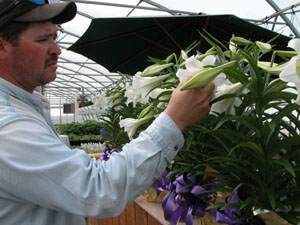By Shelley Grieshop
sgrieshop@dailystandard.com ROCKFORD -- Easter baskets, colored eggs, candy ... and Nellie Whites?

Yes, Nellie Whites, the common Easter lilies with large, white trumpet-shaped blooms, are as popular during the holiday as, well, the Easter bunny and will grace many a dining room table this weekend.
The plants with rows of thin, green leaves are even more common in Ohio, which is ranked as one of the top four states in Easter lily production.
"The biggest grower in Ohio is Green Circle Growers in Oberlin," says Aaron Fent, co-owner of A&A Greenhouse along U.S. 127 in Rockford.
Because of the high-maintenance care and the space required to grow them, Fent, like other area greenhouse operators, does not grow the towering lilies himself but orders them to sell in full bloom. The Easter lily, grown from a bulb, can be planted outside in a flower bed once its fragrant blooming season is over and there is no risk of freezing, Fent advises.
"It will die back just like your tulips do when they're done blooming," he adds.
The blooming period of an Easter lily averages about a month to five weeks, he says.
Easter lilies should be kept in daytime temperatures of 60 to 65 degrees, growers say, with slightly cooler temperatures at night. Avoid placing them near drafts or exposing them to excess heat or dry air from heating ducts, appliances or fireplaces.
"All they need is the same basic care as most house plants," says Carrie Pecharich of the Garden Emporium in Celina.
Pecharich says the plants should be kept about three feet away from a window without curtains or drapes, and the soil should be kept evenly moist. Check the plant for moisture every four to five days and be careful not to overwater.
If the plant comes home in foil, be sure it does not trap water, growers advise. For best results, remove the foil and take the plant into a sink to thoroughly water, allowing the moisture to drain off properly before replacing the foil.
When the last bloom has withered and has been cut away, you can continue to grow the Easter lily inside the home in a sunny place, if you desire. If you wish to try your hand at planting the lily outside, plant when the threat of freezing is over or in the fall and make sure its new home is sufficiently mulched in rich organic matter. Good drainage is the key and bulbs should be planted about three inches below ground level.
The name Nellie White comes from a lily grower named James White, and was named after his wife. However, it was a World War I soldier, Louis Houghton, who actually brought the lily bulbs to the United States in a suitcase upon his return home to Oregon in 1919.
Last year, the Easter lily crop in the United States had a wholesale value of nearly $40 million dollars, according to the U.S. Department of Agriculture. Not bad for a two-week window of sales.
The "Lilium longiflorum," its Latin name, is the fourth largest crop in wholesale value in the U.S. potted plant market behind poinsettias, mums and azaleas.
Easter lilies have long been the symbol of resurrection and are mentioned many times in the Bible. Called the "white-robed apostles of hope," the Good Book says the flowers grew in the Garden of Gethsemane, springing up where drops of Christ's sweat fell to the ground during his final hours.
Churches all over the world, in keeping with tradition, place the majestic plants around altars and crosses to commemorate the resurrection of Jesus Christ at Easter. |

